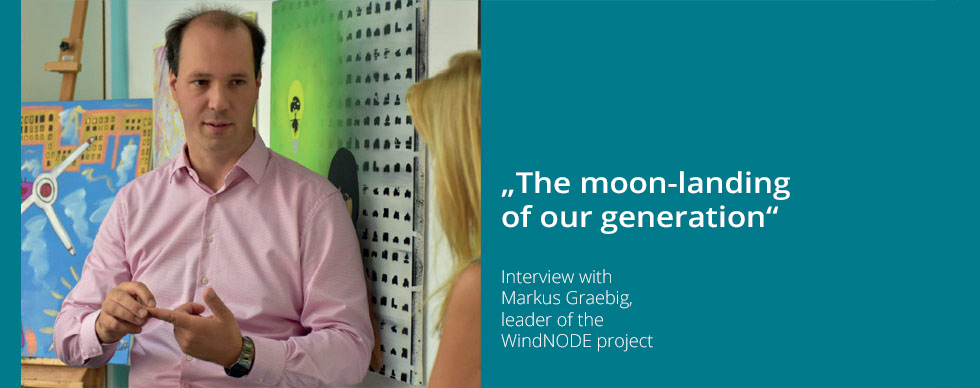Why is the energy transition so difficult? In the end we are just replacing fossil fuels with electricity from wind and sun…
At first glance it may seem easy, however, we need to have a careful look at these new energy sources: they only provide electricity while the sun is shining, or the wind is blowing – unlike power plants that continuously burn fossil fuels. Therefore, the rules of the energy system need to change. In the old system the generation followed the consumption – in the future we will increasingly need to adjust our consumption to the volatile generation. This is a paradigm shift which is why initiatives such as WindNODE and SINTEG are so important. If you consider the evolution of the German electricity mix over the last two decades, wind and solar have more or less replaced nuclear power. The nuclear phase-out is happening. However, the contribution of coal – especially lignite – has not changed much. The same can be said in other sectors – especially in the mobility sector – Germany is far from reaching its self-imposed goals. We will miss our goals for CO2 reduction in 2020, leading to one more reason why sector coupling is so important in order to ensure that the energy transition is more than just an electricity transition.
What are the real-life implications if we adjust power consumption to power generation?
First of all, we need to find technical flexibility options, i.e. those consumers whose load can be shifted in time and therefore can adjust to the supply from wind and solar. Some examples are manufacturing processes in industry or cooling aggregates in businesses such as supermarkets. Applications of sector coupling are especially interesting for example, electric heating and storage or e-mobility. However, we do not target small household consumers such as washing machines – their potential for flexibility is rather theoretical for various reasons. Secondly, we need to provide the necessary digital platforms to intelligently connect consumers and producers. Putting it simply, the flexible consumer needs to be triggered when to power up or down. This is also strongly linked to advanced forecasts of weather, generation and consumption. Thirdly, the providers of flexibility options need economic incentives to shift their loads for a stable and secure grid and systems operation. This requires totally new processes, i.e. the WindNODE flexibility platform, and new markets.
What are the biggest challenges for a successful energy transition?
From a technical perspective, the integration of large amounts of intermitting renewables into our power grid is a challenging but solvable task. This is exactly what we are working on in WindNODE: what needs to be done if more than half of the electricity comes from volatile sources? Apart from the necessary grid expansion, one of the building blocks is adjusting the consumption to generation. If we do that well, we have the chance to conquer new markets world-wide as provider of new technologies and therefore create many highly qualified jobs.
Are there more challenges?
We need to make it economically attractive for the suppliers of energy to provide the necessary flexibility. This requires new business models – and especially rules. The current regulatory framework stems from the “old energy world”. Sector coupling, in particular, is still facing prohibitive and unnecessary regulatory hurdles. Since the beginning of the century, Germany has become a frontrunner for green power generation thanks to the political decisions on a nuclear phase-out and the implementation of the “EEG”(German law for renewable energies). Now, at the dawn of the “second phase” of our energy transition, we will need to revive that political courage and visionary power.
Speaking of “visionary power”: How can you spark enthusiasm for the energy transition?
This is a crucial yet often neglected challenge. We need to highlight the huge opportunities of this vital, long-term project “energy transition” – and shouldn’t limit our discussions to half a cent more or less in electricity prices. I hope that not only do we get acceptance but that we can also spark enthusiasm. This challenge is well comparable to the moon landing: both projects are highly challenging – technically and economically. However, there is still one big difference, the moon landing fascinated the public while the energy transition is “accepted” at best with the public. Yet the energy transition could be the moon landing of our generation. The energy transition is more than the – crucial and necessary – prevention of a nuclear or climate catastrophe: technological leadership for an exporting nation, good jobs for the future, cleaner cities, decentralized participation and value generation, fascination through technology – the energy transition could be all this and more. We need to emphasize this narrative.
What could the role of art have in all of this?
For many people, energy – especially electric energy – is a rather abstract and boring topic. One that is often not even thought of. For decades, we have been told that power simply comes from the socket. The message was: don’t worry about it, just let the utilities do their job. Electricity has been a typical “low involvement product”. On the other hand, there are all these enthusiasts – engineers, economists and many more – who work passionately on the energy transition. How can we spread this passion? I think the link between energy transition and art is an inspiring and innovative approach to make the ideas and visions of WindNODE more tangible and easier to understand. Many people love art so what would be more obvious than using this interest to incite excitement for the abstract energy transition. First, art can create the willingness to have a closer look at the energy transition. It can provide access to a change of perspectives in order to rethink and allow one to come to their own conclusions. And lastly, art can help to make the seemingly dry topic fun.

